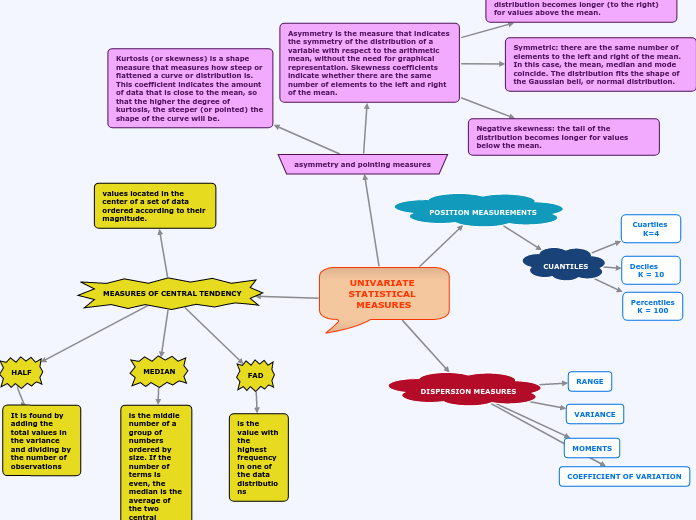UNIVARIATE STATISTICAL MEASURES
MEASURES OF CENTRAL TENDENCY
values located in the center of a set of data ordered according to their magnitude.
HALF
It is found by adding the total values in the variance and dividing by the number of observations
MEDIAN
is the middle number of a group of numbers ordered by size. If the number of terms is even, the median is the average of the two central numbers
FAD
is the value with the highest frequency in one of the data distributions
POSITION MEASUREMENTS
CUANTILES
Cuartiles K=4
Deciles K = 10
Percentiles K = 100
DISPERSION MEASURES
RANGE
VARIANCE
MOMENTS
COEFFICIENT OF VARIATION
asymmetry and pointing measures
Asymmetry is the measure that indicates the symmetry of the distribution of a variable with respect to the arithmetic mean, without the need for graphical representation. Skewness coefficients indicate whether there are the same number of elements to the left and right of the mean.
Positive skewness: the tail of the distribution becomes longer (to the right) for values above the mean.
Symmetric: there are the same number of elements to the left and right of the mean. In this case, the mean, median and mode coincide. The distribution fits the shape of the Gaussian bell, or normal distribution.
Negative skewness: the tail of the distribution becomes longer for values below the mean.
Kurtosis (or skewness) is a shape measure that measures how steep or flattened a curve or distribution is.
This coefficient indicates the amount of data that is close to the mean, so that the higher the degree of kurtosis, the steeper (or pointed) the shape of the curve will be.
